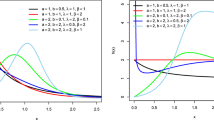Abstract
We consider a queueing system in which a single server attends to N priority classes of customers. Upon arrival to the system, a customer begins to accumulate priority linearly at a rate which is distinct to the class to which it belongs. Customers with greater accumulated priority levels are given preferential treatment in the sense that at every service selection instant, the customer with the greatest accumulated priority level is selected next for servicing. Furthermore, the system is preemptive so that the servicing of a customer is interrupted for customers with greater accumulated priority levels. The main objective of the paper is to characterize the waiting time distributions of each class. Numerical examples are also provided which exemplify the true benefit of incorporating an accumulating prioritization structure, namely the ability to control waiting times.
Similar content being viewed by others
References
Abate J, Whitt W (1995) Numerical inversion of Laplace transforms of probability distributions. ORSA J Comput 7:36–43
Bagchi U (1984) A note on linearly decreasing, delay-dependent non-preemptive queue disciplines. Oper Res 32:952–957
Bagchi U, Sullivan RS (1985) Dynamic, non-preemptive priority queues with general, linearly increasing priority. Oper Res 33:1278–1298
Brill PH (2008) Level crossing methods in stochastic models. Springer, New York
Conway RW, Maxwell WL, Miller LW (1967) Theory of scheduling. Addison-Wesley, Reading
Drekic S (2003) A preemptive resume queue with an expiry time for retained service. Perfor Eval 54:59–74
Fajardo VA, Drekic S (2015) Controlling the workload of M/G/1 queues via the q-policy. Eur J Oper Res 243:607–617
Holtzman JM (1971) Bounds for a dynamic-priority queue. Oper Res 19:461–468
Hsu J (1970) A continuation of delay-dependent queue disciplines. Oper Res 18:733–738
Jackson JR (1960) Some problems in queueing with dynamic priorities. Naval Res Logistics Q 7:235–249
Jackson JR (1961) Queues with dynamic priority discipline. Manag Sci 8:18–34
Jackson JR (1962) Waiting-time distributions for queues with dynamic priorities. Naval Res Logistics Q 9:31–36
Jaiswal NK (1968) Priority queues. Academic Press, New York
Kanet J (1982) A mixed delay dependent queue discipline. Oper Res 30:93–96
Keilson J, Servi LD (1990) The distributional form of Little’s law and the Fuhrmann-Cooper decomposition. Oper Res Lett 9:239–247
Kleinrock L (1964) A delay dependent queue discipline. Naval Res Logistics Q 11:329–341
Kleinrock L, Finkelstein RP (1967) Time dependent priority queues. Oper Res 15:104–116
Netterman A, Adiri I (1979) A dynamic priority queue with general concave priority functions. Oper Res 27:1088–1100
Sharma KC, Sharma GC (1994) A delay dependent queue without preemption with general linearly increasing priority function. J Oper Res Soc 45:948–953
Stanford DA, Taylor P, Ziedins I (2014) Waiting time distributions in the accumulating priority queue. Queueing Syst 77:297–330
Takagi H (1991) Queueing analysis, volume 1, vacation and priority systems, part 1. North Holland
Trivedi SK, Jain M, Sharma GC (1984) A delay dependent queue with preemption. Indian J Pure Appl Math 15:1296–1301
Wolff RW (1982) Poisson arrivals see time averages. Oper Res 30:223–231
Author information
Authors and Affiliations
Corresponding author
Rights and permissions
About this article
Cite this article
Fajardo, V.A., Drekic, S. Waiting Time Distributions in the Preemptive Accumulating Priority Queue. Methodol Comput Appl Probab 19, 255–284 (2017). https://doi.org/10.1007/s11009-015-9476-1
Received:
Revised:
Accepted:
Published:
Issue Date:
DOI: https://doi.org/10.1007/s11009-015-9476-1
Keywords
- Accumulating priority
- Preemptive priority
- Dynamic priority queues
- Maximal priority process
- Laplace-Stieltjes transform



